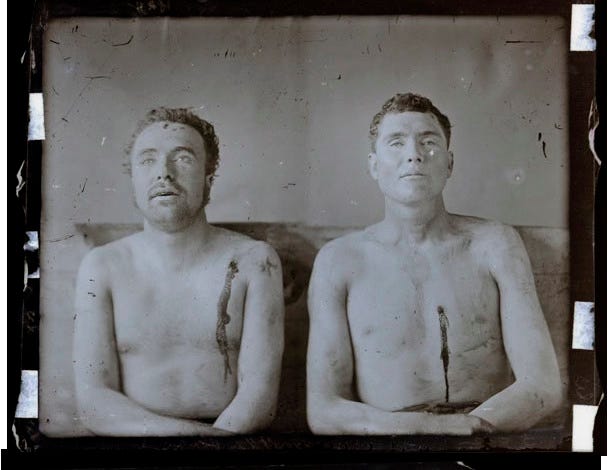Was Scott County man killed in one of the James Gang's robberies?
The answer is almost certainly 'no.' We explore the legend.
You’re reading “Echoes in Time,” a weekly newsletter by the Independent Herald that focuses on stories of years gone by in order to paint a portrait of Scott County and its people. “Echoes in Time” is one of six weekly newsletters published by the IH. You can adjust your subscription settings to include as many or as few of these newsletters as you want. If you aren’t a subscriber, please consider doing so. It’s free!
Today’s newsletter is sponsored by the Scott County Chamber of Commerce. Since 1954, the Scott County Chamber of Commerce has advocated for a strong community by supporting stronger infrastructure and leadership.
The confusion of Mitt Adkins and Clell Miller

In the late 1860s, as a young storekeeper named Dave Moore lodged and did business in Huntsville, suspicions began to grow that he was, in fact, someone more than who he claimed to be.
Through the years, a legend developed that this mysterious man — who was only in Huntsville for about six months — was actually the outlaw Jesse James, little-known at the time of Dave Moore’s tenure in Scott County but soon to become famous.
Both of Scott County’s preeminent 20th century historians, H. Clay Smith and Esther Sharp Sanderson, wrote about the legend of Jesse James, using eyewitness accounts to build a compelling case that Dave Moore was, in fact, the vengeful outlaw whose reign of terror in his native Missouri lasted more than a decade.
Both Smith and Sanderson, in their books Dusty Bits of the Forgotten Past and County Scott and Its Mountain Folk, wrote similar accounts of Jesse James’ supposed stint in Huntsville. Each of them also included details that the other did not, and Sanderson wrote that one of the things rousing suspicion was the disappearance of a Buffalo man named Mitt Adkins, who vanished from Scott County about the same time that a man named Clell Miller was killed during one of the James Gang’s robberies in Missouri. The assumption was that Mitt Adkins was actually Clell Miller, using an assumed name.
But was he really?
The answer is almost certainly “no.” First, though, who was Mitt Adkins?
He may have been Milton Adkins, part of the same eastern Scott County Adkins clan that included Rev. Sterling Adkins, founder of the Baptist churches at Smokey Creek and Upper Jellico Creek.
Milton Adkins was the son of Henry and Elizabeth Adkins, born about 1841. His father, born about 1817, may have been a brother to John Stanton Adkins of Jellico Creek, which would have made him an uncle to Sterling Adkins.
Milton appeared in the 1850 census as 9-year-old “Melton Adkins,” the only child living in the home of Henry and Elizabeth Adkins. He appeared in the 1860 census as 19-year-old “Millon Actkins,” still living in his parents’ home, along with an 18-year-old Nancy Adkins who may very well have been his wife.
And then Milton Adkins simply disappears from the public record. Henry and Elizabeth moved to Campbell County, where they were found in the 1870 and 1880 censuses, before dying sometime between 1880 and 1900 (Elizabeth Adkins filed a widow’s Civil War pension claim in 1893). But Milton Adkins was nowhere to be found.
Little wonder, then, that historians would many years later come to assume that Mitt Adkins may have been killed in a Missouri robbery.
The timeline fits. It was about 1867 that Jesse James supposedly came to Scott County, and about 1868 when he supposedly returned to Missouri. By the time the 1870 census was taken, Mitt Adkins did not appear in local census records.
The problem is that Clell Miller, the man who might have actually been Mitt Adkins, was actually a well-known outlaw in Missouri, and his lineage can be traced.
Born around December 1849 or January 1850, Clell Miller was the son of Moses W. Miller and Martha Ann Willhite of Kearney, Mo. — the hometown of Jesse James. His real name was Cleland Miller, or Clenand Miller. He appeared in the 1850 census as Clenand Miller, age 0, and in the 1860 census as Cleeland Miller, age 10. He was listed in the 1870 census as 21-year-old Cleander Miller.
At the age of 14, Clell Miller joined Bloody Bill Anderson’s band of guerrillas, which sided with the Confederacy during the Civil War. He was captured during the skirmish in which Anderson was killed on October. 26, 1864. He might have been executed if not for his youth; instead, he was sent to the Gratiot Street Prison in St. Louis, Mo. His father later obtained his release in April 1865 by testifying that the family had always been Union supporters.
The first time Clell Miller is known to have appeared with the James Gang was on June 3, 1871, when the Ocobock Brothers’ bank was robbed in Corydon, Ia. Miller was subsequently captured by a detective from the Pinkerton Detective Agency. However, a long list of witnesses testified on his behalf when he went to trial, and he was acquitted. He denied being in the James Gang at the time, but said later that he “might as well join them because his reputation had been ruined by the trial.”
The next April, a bank was robbed in Columbia, Ky. A cashier was killed and a bystander was wounded. Miller was said to have been present. He was also present at a bank robbery in Missouri in 1873, the robbery of a stagecoach and a train in January 1874, the robbery of a general store in Arkansas in February 1874, a stagecoach robbery in Texas in April 1874, a railroad robbery in Kansas in December 1874, the killing of Pinkerton ally Daniel Askew in April 1875, the killing of Pinkerton agent Jack Ladd in April 1875, and a railroad robbery in Missouri in July 1876.
On Sept. 7, 1876, Miller was shot and killed by townspeople in Northfield, Minn., during a robbery attempt at First National Bank of Northfield. Fellow outlaw Bill Chadwell was also killed. Frank James, Cole Younger, Jim Younger and Bob Younger were all wounded. So was Charlie Pitts, who later died.
Miller was initially buried in Northfield. His father later claimed the body and moved it to Muddy Fork Cemetery in Kearney. One night after he was buried the second time, his body — along with Chadwell’s — was exhumed and placed into a wooden barrel labeled “paint.” It was shipped to a medical school in Ann Arbor, Michigan., where a medical student used the body as a cadaver and displayed the skeleton in his office.
Clell Miller had a younger brother, Ed Miller, who also served in the James-Younger Gang and was murdered by Jesse James in 1881. He was portrayed by Dennis Quaid in the movie The Long Riders.
There’s no compelling evidence to either prove or disprove that Jesse James spent time in Scott County in the 1860s. The truth of the matter may never be known. However, it’s pretty clear that the outlaw Clell Miller was not Scott County’s Mitt Adkins. Instead, it seems Mitt Adkins simply had the misfortune of disappearing about the time Jesse James may have spent time in Scott County, leading to later speculation by historians.
So what happened to Mitt Adkins? That much may never be known. The Milton Adkins who was the son of Henry and Elizabeth Adkins does not appear in public records after 1860. Did he die prior to the 1870 census? If so, where is he buried? Those are questions without answers.
Thank you for reading. Our next newsletters will be Threads of Life on Wednesday and The Weekender Thursday evening. Want to update your subscription to add or subtract these newsletters? Do so here. Need to subscribe? Enter your email address below!
◼️ Monday morning: The Daybreaker (news & the week ahead)
◼️ Tuesday: Echoes in Time (stories of our history)
◼️ Wednesday: Threads of Life (obituaries)
◼️ Thursday evening: The Weekender (news & the weekend)
◼️ Friday: Friday Features (beyond the news)
◼️ Sunday: Varsity (a weekly sports recap)



